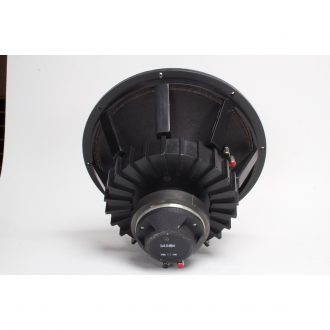Urei 813B Coaxiel Driver #2 (Vintage)
$475.00
Description
Urei 813B Coaxiel Driver (Vintage)
Info courtesy of Mix Magazine:
In the mid-’70s, UREI founder Bill Putnam—unhappy with the sound of the Altec 604 monitors in his United Western Studios—worked with UREI’s Dean Austin and Dennis Fink on ways to improve the 604. They replaced Altec’s multicell horn with a wider dispersion design and added a 15-inch Eminence woofer to boost LF output. Ed Long applied his Time-Align™ crossover techniques to achieve time- coherent, true point-source performance.
Engineers and producers mixing on the system were so enthusiastic about its sound that UREI started producing the monitors as a commercial product, with the first UREI 813 debuting in 1977. Typically soffit-mounted, these large, double-15 monitors were ideal for the larger, higher-SPL control rooms of the time.
Two years later, Altec replaced its Alnico 604-8H with a ferrite model, requiring modifications to the 813 design, including a foam diffraction buffer, crossover mods and small Helmholtz resonators in the horn flare. This 1979 model was the 813A, followed by the 815A (a 604, plus two extra woofers) and the single-driver 811A, but the 813A was far more popular.Financial and QC problems at Altec led UREI to find a new driver source, now mating PAS coaxial 15 to a JBL 2425 compression driver. The new 813B version debuted in 1983. Later that year, Putnam sold the business to Harman, with UREI becoming a division of JBL Professional; the 813C, a new model with all JBL drivers, launched in 1984. But in its various incarnations, the UREI 813 was the most successful large-format studio monitor ever made.
THE UREI SERIES B
TIME ALIGN®
STUDIO MONITORS
FEATURES:
Flat power response maintains frequency balance at
low distortion over wide range of output levels.
Time Align® design achieves accurate time domain
response, minimizing fatigue while listening at high
sound pressure levels.
One- point sound source.
Highly controlled sound field over entire frequency
range.
Accurate stereophonic imaging.
Consistent ratio of direct to reverberant sound.
Since their introduction the UREI Time Align®studio
monitors have continually been installed in more and
more recording studios and broadcast production
facilities worldwide to replace older (and some newer)
monitor designs.
Series B is the third generation of UREI monitors.
These monitors all feature a proprietary coaxial loud-
speaker which has been developed by UREI engineers.
Through the utilization of the latest advances in materials
and fabrication techniques in the manufacture of the
coaxial loudspeakers, the following system characteristics
make them ideal for the most demanding program
material:
High sensitivity, high power handling capability and
extended high frequency response.
The performance breakthroughs which have been
accomplished in designing the Series B monitor systems
have made it possible to double the sensitivity to input
signals and the power handling capability. The coaxial
loudspeaker incorporates a JBL 2425H driver in the high-
frequency section which extends the high frequency
response envelope ... to beyond 17.5 kHz.
The Series B monitors have the patented high fre-
quency horn, with its diffraction buffer for correct
acoustic impedance matching and smooth out-of-band-
response, and the shadow slots which eliminate the
midrange shadowing common to conventional coaxial
loudspeaker horns. The ceramic magnet structures used
on all of the drivers in the 800-serles monitors assure
that the sensitivity of these systems will not tend to
degrade with time, even under continuous use at high
monitoring levels.
Each UREl Series B monitor uses the new 801 B coaxial
driver to provide a true one-|X)int sound source.
Additional low-frequency drivers are utilized in the 813 B
and 815B for extended low-frequency response and
greater overall sensitivity without sacrificing the
tight bass, superior stereo imaging, and all of the
other characteristics which you have come to expect
from studio monitors by UREI.
TIME OFFSET CORRECTION
Even though a coaxial loudspeaker delivers the entire
frequency spectrum from one source, the voice coils of
the two transducers are displaced from each other, and
the low and high frequency portions of a sound do not
Additional information
| Brand | Urei |
|---|












